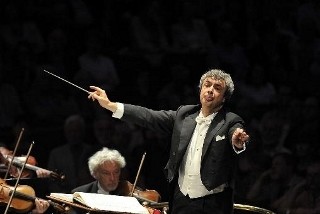|
Back
Needing Resurrection New York
Stern Auditorium, Carnegie Hall
10/28/2018 - & October 10 (Prague), 12 (Bratislava), November 26, 27 (Vienna), 2018
Gustav Mahler: Symphony No. 2
Christiane Karg (Soprano), Elisabeth Kulman (Mezzo-Soprano)
Prague Philharmonic Choir, Lukás Vasilek (Principal Conductor), Czech Philharmonic, Semyon Bychkov (Music Director and Chief Conductor)

S. Bychkov (© Chris Christodoulou)
“Mahler seems very logical to me in its completely crazy, illogical way. It never seemed like a puzzle which one needs to solve.”
Iván Fischer
“…Mahler, a Jew who is currently assistant conductor at the Royal Court Theatre, has been named principal conductor…This satisfied the different racial types, the Germans having all the work, while the Jew received all the credit. Oh what fun it was to help turn a dear old Jew into a genius by writing and talking him up.”
Unnamed newspaper article quoted in Gustav Mahler by Jens Malte Fischer
I grew up in a neighborhood in the United States that was well over 90 percent Jewish and I did not have any close Christian acquaintances until high school. By that time I had almost totally absorbed the works of Mahler (it was the 1950’s) but had no ingrained sense of their “outsider” identity. In fact, I never really understood the emotional trauma of Mahler until I first went to Vienna and saw that the Hofburg was just across the courtyard from the Staatsoper. Talk about the boss looking over your shoulder!
In the Symphony #2 Mahler reaches back to his settings of poems from the folksong collection Des Knaben Wunderhorn (“The Youth’s Magic Horn”) and fashions two movements, the third and fourth, after themes from this collection. The bizarre Scherzo of the second, subtitled Die Welt wie im Hohlspiegel ("The World as in a Concave Mirror") is set to the music of the song Des Antonius von Padua Fischpredigt (“St. Anthony Preaches to the Fish”), a slightly off-center tune that tells the story of the evangelist who, finding the church empty, brings the joy of the gospel to the beasts of the ocean. Here the hero’s memory is out of sync with reality. The composer described the feeling as one of seeing a crowded ballroom filled with dancers but being unable to hear the music that propelled them. This setting and the spiritual song Urlicht (“Primeval Light”) make up the middle of this “Resurrection” Symphony. Mahler also plays with the device of memory when he establishes in the first movement a fleeting flute motive which reappears during the apocalyptic finale as the full-blown figure of the Bird of Death.
Semyon Bychkov established himself primarily as a beat-keeper in the opening Totenfeier (“funeral rites”) section. This reading quickly established itself as a fussy example of all of the entrances and exits without much of the music. The conductor adopted precision as his watchword but, in so doing, left out much of the expressiveness and ultimate horror of this first phantasmagoric Mahlerian essay. Although the stage was full, the hall was not. After some minutes, I became engrossed in a spat directly across the aisle from my seat, as a young teenager was having a heated discussion with what seemed to be her parents and kept shifting around in her seat to get in one more “final” word. With the choir already seated on the stage, there was little to do during the break between the first two movements. The soloists did enter and Mr. B spent an inordinate amount of time wiping the sweat from his head, but otherwise the long and somewhat awkward silence ended with, of all things, a complete re-tuning of the troops. Somewhat uncomfortable.
The Andante of the Second Symphony is the first movement of this composer to be entirely based on the popular Schrammelmusik of the day. This Viennese danceband style has come to be associated with Mahler and seems nostalgic to a modern listener because of the many movements in his works which are meant to convey the feeling that something wonderful has passed forever. Perhaps the composer did not intend this miniature jewel of a movement to seem nostalgic, but the effect on a twenty-first century listener is unmistakably that of lost charm and grace (a similar phenomenon exists in the best work of Johann Strauss, Jr.). The main difference between Mahler and J. Strauss is that Mahler knew that he was composing for a time period of the distant future while Strauss reveled in his own contemporaneity. Two very different perspectives.
Unabashedly, Bychkov continued to lead a lackluster, albeit safe, performance. Everything progressed innocuously until the finale, when trumpets and horns either rebelled or simply wore out their lips (or their welcome) and began to indulge in a paroxysm of badly slurred or simply incorrect notes. Both solo singers were fine, although why Ms. Kulman stood and Ms. Karg sat! was a bit of a puzzle. Suffice it to say that this performance was a severe disappointment.
Years ago I took the tour of Carnegie Hall and when we stopped at the spot honoring Mahler, the guide noticed that no one (except me) even knew who that was. I still shudder today to recall...
Fred Kirshnit
|